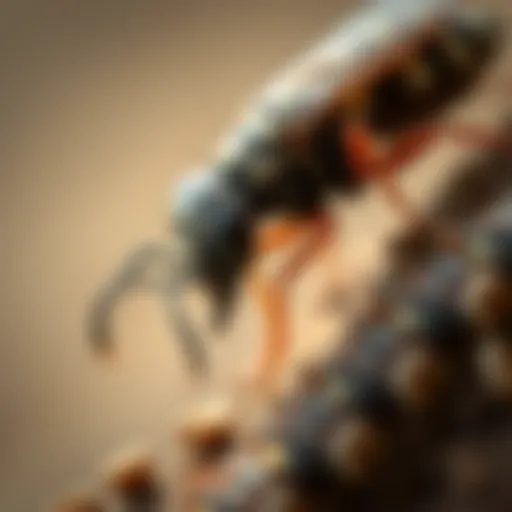Effective Strategies to Repel Woodpeckers from Your Home
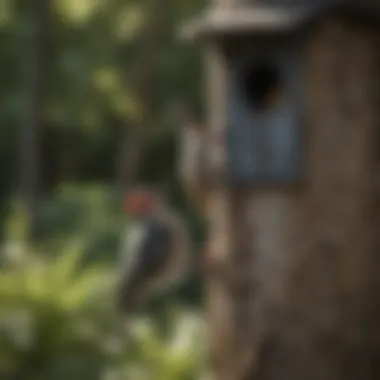

Intro
Woodpeckers can be beautiful to observe in their natural habitat. However, when they choose your home as their territory, their activities can lead to unwelcome damage. This article provides a detailed overview of effective strategies to repel woodpeckers, ensuring your residential property remains intact. We will look into identification, life cycle, prevention methods, and other control tactics to facilitate a harmonious environment with these birds while minimizing damage to your home.
Understanding the Pest
Identification
To effectively deter woodpeckers, it is crucial to identify which species are causing the problem. Common types that may invade residential areas include the Downy Woodpecker and the Northern Flicker. They often exhibit distinct behavior such as pecking on wooden surfaces, which creates irritating noises and potential structural damage. Key features include:
- Size: Typically range from 6 to 12 inches in length.
- Color: Most have contrasting colors, generally with black and white patterns.
- Behavior: Drumming sounds and visible pecking on wood are clear signs.
Life Cycle
Understanding the life cycle of woodpeckers can aid in timing your repellent strategies. Woodpeckers typically breed in early spring. They create nesting holes in tree trunks or wooden structures. After mating, they lay about 3 to 6 eggs. The hatchlings are dependent and remain in the nest for several weeks.
- Spring: Active mating and nesting period.
- Summer: Young birds leave the nest but may continue to return for food.
- Fall/Winter: Woodpeckers may expand their foraging range, which may lead them back to your home.
Keeping track of these stages can enhance your control measures, helping you to act effectively at the right time.
Pest Prevention Strategies
Environment Modification
Making your property less appealing to woodpeckers can significantly reduce their presence. Here are several strategies:
- Remove food sources: If you have fruit trees or suet feeders, consider relocating them.
- Maintain trees: Regularly check for signs of pest damage on trees, as this can attract woodpeckers looking for insects.
- Sound disruption: Implement wind chimes or other noise-making devices to create an unsettling environment.
Physical Barriers
Implementing barriers can also help prevent access:
- Netting: Use bird netting to cover vulnerable areas.
- Reflective materials: Install shiny objects like aluminum foil or reflective tape. These can deter birds due to their flashing movements in sunlight.
- Woodpecker-proof siding: Consider replacing vulnerable wooden surfaces with materials like vinyl or aluminum.
Control Methods
Chemical Control
Chemical deterrents are not always the best option as they can pose environmental harm. However, certain non-toxic repellents might be effective in some scenarios:
- Methyl Anthranilate: This compound is often used as a bird repellent. It is generally safe for humans and non-target wildlife.
Biological Control
Encouraging natural predators can also help manage woodpecker populations without harm:
- Encourage hawks: Installing perches or nesting boxes can attract hawks that may prey on smaller birds, thereby naturally reducing woodpecker presence.
Each of these methods serves to address woodpecker issues while maintaining ecological balance, ensuring humane treatment of these birds. With careful implementation of these strategies, homeowners can protect their investments from the damaging effects of woodpecker activities.
Understanding Woodpecker Behavior
To effectively manage woodpeckers around residential areas, understanding their behavior is essential. It informs homeowners about the reasons these birds may be drawn to their properties. Knowledge of woodpecker behavior assists in choosing the appropriate strategies for deterrence, ensuring that homeowners can act based on the specific habits and preferences of woodpeckers.
Why Woodpeckers Visit Homes
Woodpeckers are often attracted to homes for several reasons. One major factor is the availability of food sources. Insects residing within wooden structures are an appealing target for woodpeckers seeking nourishment. Many homeowners may not realize that damp or decaying wood can harbor an ideal habitat for larvae and beetles, creating an inviting buffet for these birds.
Additionally, woodpeckers may find nesting sites in and around homes. Properties with older trees or wooden siding can provide safe havens for their nests. Moreover, the sound of woodpecking can also be a form of territorial behavior, as male woodpeckers establish dominance by drumming on surfaces. Thus, the act of visiting homes can be driven by both sustenance and shelter.
Common Species and Their Habits
Various woodpecker species exhibit distinct habits that can influence how they interact with human environments. The Downy Woodpecker, for example, is smaller and more frequently seen flitting around backyard trees or shrubs. Their feeding habits involve pecking at branches in search of insects. On the other hand, the Northern Flicker is often found on the ground, foraging for ants and beetles, which can lead them to approach homes seeking food.
Each species also has unique preferences for nesting. The Pileated Woodpecker, one of the largest species in North America, prefers large trees with rotting wood, while the Hairy Woodpecker tends to favor dying trees. Recognizing these preferences can aid homeowners in understanding how to modify their environment to discourage visits from specific woodpecker species.
Seasonal Patterns of Woodpecker Activity
Woodpecker activity is highly seasonal, influenced by mating and feeding behaviors. During the spring, male woodpeckers drum to attract females and establish territory. This can lead to increased noise levels and drilling activity around homes, which many homeowners might find disruptive.
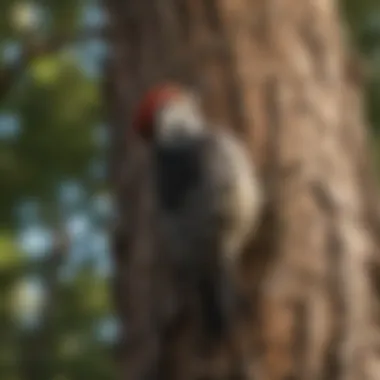

In summer, woodpeckers are usually busy feeding their young, and visual signs of their presence may increase as they chase after insects. Fall sees a decrease in activity as many species migrate or find new places to forage. Conversely, winter can bring woodpeckers looking for food sources, as insects become less available in the chill.
Understanding these seasonal patterns helps homeowners anticipate when woodpecker visits may peak. By knowing this, they can take proactive measures during high-activity periods to minimize potential damage.
Assessing Woodpecker Damage
Assessing woodpecker damage is crucial for homeowners. Understanding the nature and extent of any damage can help in developing effective strategies to address the issue. Without proper assessment, it becomes difficult to determine which solutions will be most effective and safe for your property and the birds.
Recognizing how severe the damage is can aid in prioritizing solutions. If ignored, woodpecker activity can lead to significant structural problems. This section provides a framework for identifying signs of infestation and evaluating the overall damage to better inform your approach to prevention and repair.
Identifying Signs of Infestation
Detecting woodpecker infestations early can save time and money. Homeowners should watch for specific signs that indicate woodpecker presence. Here are common indicators:
- Drilling Holes: Look for small holes in your home's siding or eaves. Woodpeckers often peck in search of food or for nesting.
- Chipping Bark: Damage to trees or wood structures may occur as woodpeckers search for insects.
- Drumming Sounds: Woodpeckers are known for their drumming, especially during mating season. If you hear this sound regularly, suspect nearby nesting.
- Feather Fragments: In areas with bird activity, feathers near the site can indicate regular visits.
It's essential to remain observant to these signs. This will help in early detection and mitigate more considerable issues later on.
Evaluating the Extent of Damage
Once you identify signs of an infestation, the next step is evaluating the extent of the damage. Homeowners should consider the following factors:
- Size of Holes: Measure the dimensions of any holes found. Larger holes could signify more serious issues.
- Location of Damage: Damage on the house's exterior can compromise insulation and structural integrity.
- Impact on Surroundings: Consider if nearby trees or wooden structures also show signs of damage. This can indicate a more extensive problem.
- Cost of Repairs: Estimate potential repair costs, which can vary widely based on the extent of damage.
The evaluation process should be thorough. This helps homeowners decide on the best course of action and whether professional help is needed.
Assessing woodpecker damage accurately lays the foundation for effective management strategies.
Environmental Modifications
Environmental modifications play a critical role in discouraging woodpeckers from invading your living space. By making your property less inviting, you can effectively reduce the chances of these birds becoming a problem. This approach is often preferred because it aligns with humane practices, promoting coexistence rather than confrontation.
When implementing such modifications, it is important to consider the specific habits of woodpeckers. They are attracted to certain environments that provide food, nesting sites, or even simply suitable places to drum and establish territory. Hence, your efforts should focus on disrupting these attractants by altering landscape and habitat features.
Creating an Unappealing Habitat
To reduce the chances of woodpeckers visiting your home, start by altering their habitat. Examine your yard and property for elements that might draw their attention. Keep in mind the following tips:
- Remove Standing Water: Woodpeckers often seek out sources of drinking water. Removing birdbaths or draining standing water can help dissuade them.
- Limit Insect Populations: Woodpeckers feed on insects, especially those found in trees. Regularly inspect and treat your trees for infestations, thus eliminating their food source.
- Prune or Remove Attractively Damaged Trees: Trees with holes or peeling bark can attract woodpeckers. Pruning these trees or removing them altogether can significantly diminish their appeal.
Implementing these changes can alter the perception of your space, making it a less preferred choice for woodpeckers.
Adjusting Bird Feeders and Bird Baths
Your current setup for feeding birds can also impact woodpecker visits. If you have bird feeders or baths set up, consider how they might attract woodpeckers. Adjusting these can be simple yet effective:
- Use Selective Feeders: Opt for feeders designed to deter larger birds. Some products are effective in keeping woodpeckers at bay while still attracting smaller species you might enjoy.
- Relocate Feeders: If your bird feeders are positioned near wood siding or trees, relocating them to more open or less appealing areas can remove the incentive for woodpeckers to linger.
- Cover or Store Feeder During Peak Activity: During the times of year when woodpeckers are most active, consider removing feeders or covering them to make the area less inviting.
By thoughtfully considering how your outdoor arrangements may contribute to woodpecker visits, you can make strategic changes that lead to a more peaceful coexistence while safeguarding your home.
Physical Barriers and Deterrents
The presence of woodpeckers can cause significant damage to homes if not addressed properly. Utilizing physical barriers and deterrents is a fundamental strategy in this regard. These measures act as protective layers, either blocking access or making the environment unfriendly for woodpeckers. By implementing these strategies, homeowners can mitigate the risk of damage while maintaining a balance in their environment.
Installing Netting or Mesh
Installing netting or mesh is an effective way to prevent woodpeckers from accessing areas they usually peck. This method is particularly useful for protecting the sides of homes and eaves. When selecting the right type of netting, it’s important to choose materials that are durable and weather-resistant. The mesh should have small enough openings to prevent woodpeckers from getting through, ideally less than one inch.
To install netting successfully, consider securing it tightly against the surface of your home. This will limit fluttering that could potentially attract birds. Additionally, it's important to extend the netting several feet from the wall, creating a barrier that woodpeckers cannot navigate around. Regular inspections of the netting ensure it remains intact.
Hanging Reflective Objects
Hanging reflective objects can effectively deter woodpeckers by causing confusion through their reflective surfaces. Items like old CDs, aluminum foil strips, or metallic tape can be hung in areas where woodpeckers are frequenting. The sunlight reflecting off these objects creates movement and flashes that birds generally avoid.
When implementing this method, spacing the reflective objects close enough can enhance the effectiveness. Each object should be hung in a way that allows it to move with the wind. This movement, combined with the reflection, increases its deterrent quality. However, it is crucial to remember that these methods need occasional re-evaluation, since birds may adapt to them over time. Replacement or additional objects can be incorporated as necessary.
Using Spikes or Sound Devices
Employing spikes or sound devices provides another layer of defense against woodpecker intrusion. Spikes can be installed on potential nesting sites or areas of damage to physically block access. They are designed to be humane and deter birds without inflicting harm.
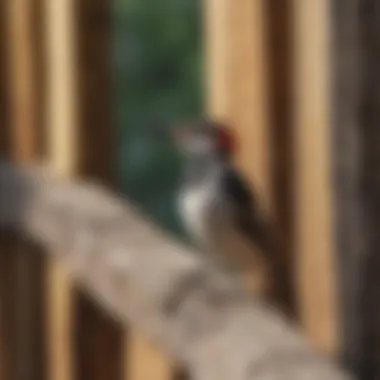

On the other hand, sound devices can emit noises that are unpleasant to birds. Some homeowners may choose devices that produce sounds mimicking predator calls, while others may find success with ultrasonic devices. Regardless of the choice, positioning is critical. Devices should be placed near areas where woodpecker activity is noted, ensuring that they cover relevant spaces effectively. Sound devices may require periodic adjustments based on the effectiveness or bird behavior changes.
For optimal results, combine physical barriers with other strategies discussed in this article to create a comprehensive approach to woodpecker management.
Natural Deterrents
Natural deterrents offer a sustainable approach to managing woodpecker populations around residential properties. These methods rely on natural elements to create environments that are less attractive to woodpeckers, integrating seamlessly into the ecosystem. Employing these strategies not only helps in reducing woodpecker interference but also enhances the overall appeal of your garden or yard.
Planting Specific Vegetation
Selecting the right plants can significantly influence the presence of woodpeckers. Certain plants produce fruits or seeds that can attract various bird species, including woodpeckers. To reduce their allure, consider planting species that are less appealing to them.
For example, thorny bushes like blackberry or raspberry may deter woodpeckers, as they prefer areas that are open and devoid of substantial barrier vegetation. Additionally, introducing deciduous trees with smooth bark can discourage woodpecker activity, as these birds often seek softer woods for pecking. However, avoid planting fruit trees or nut-bearing trees, such as apples or oaks, since these are likely to draw them in instead.
Top Recommended Vegetation:
- Hawthorn: Provides dense cover and thorny varieties.
- Juniper: Offers dense foliage that deters invasion.
- Privet: Creates a thick, impenetrable shrub layer.
By creating barriers through thoughtful planting, you can enhance your yard's protective measures against woodpeckers.
Employing Essential Oils and Scents
Essential oils can serve as powerful natural repellents for woodpeckers. Their acute sense of smell makes certain scents bothersome or unappealing to these birds. When using this method, it is important to choose oils with strong aromas that are known to deter various bird species.
Peppermint oil, for example, can be notably effective. It not only offers a pleasant fragrance for humans but also functions as a deterrent due to its strong scent. Mixing peppermint oil with water in a spray bottle and applying it around frequented areas can form an invisible barrier. Another scent, cinnamon oil, is also known for its efficacy in repelling birds.
Application Tips:
- Mix 10-15 drops of essential oil with water in a spray bottle.
- Spray the mixture near areas where woodpeckers are active.
- Reapply every few days or after rainfall to maintain effectiveness.
Using essential oils is not only an effective method but also eco-friendly. This approach aligns with the goal of promoting coexistence with wildlife while protecting your home.
"Employing natural deterrents fosters a balanced relationship with the ecosystem while addressing your concerns about woodpecker damage."
These natural strategies reflect a thoughtful consideration of your surroundings and convey a commitment to humane wildlife management.
Humane Solutions for Woodpecker Management
Humane solutions for woodpecker management are crucial for homeowners facing challenges from these birds. Recognizing the need for a balance between effective deterrence and ethical considerations is essential. Woodpeckers play a role in the ecosystem, helping control insect populations and promoting plant growth. Therefore, managing their presence should ideally involve approaches that do not harm them.
The benefits of adopting humane strategies extend beyond just protecting your home. They foster a sense of responsibility and respect for wildlife, ensuring that such interactions remain positive rather than confrontational. Furthermore, many of these methods are also low-cost and environmentally friendly. The focus should be on encouraging woodpeckers to relocate instead of eliminating them.
Relocating Nesting Sites
Relocating nesting sites is a practical humane strategy that homeowners can consider. Woodpeckers are often driven to our homes by the availability of suitable places to raise their young. Before undertaking any relocation efforts, it is vital to first determine whether the woodpecker is indeed nesting. Signs of nesting include persistent drilling or pecking in the same area, or even visible nests.
If a nest is present and active, it’s crucial to wait until the young have fledged before taking action. Once the nesting period is over, relocation can involve enhancing nearby areas that are more suitable for woodpeckers. This might mean creating cavities in trees or installing artificial nesting boxes at a distance from your home. These boxes can be designed to cater to woodpecker species, providing them with a safe alternative while reducing their interest in your property.
Using Decoys
Using decoys is another effective humane measure in deterring woodpeckers from your home. Birds are territorial creatures, and they often avoid areas where they perceive potential competition. By placing decoys, such as fake owls or other predatory birds, you can create an illusion of danger. This strategy can be especially effective if the decoys are positioned in visible areas where woodpeckers typically frequent.
It is important to note that the effectiveness of this method can vary. Regular rotation of decoy placements may keep the illusion fresh for woodpeckers. Furthermore, integrating shiny reflective objects alongside decoys can enhance the deterrent effect. Consider using materials such as aluminum foil or reflective tape. This layered approach can significantly reduce the likelihood of woodpecker activity around your home without causing harm to these fascinating birds.
By implementing humane solutions, you not only protect your home but also contribute to the preservation of local wildlife.
Professional Woodpecker Management Services
In the realm of managing woodpecker issues, the significance of enlisting professional woodpecker management services cannot be overstated. While many homeowners may resort to DIY methods or temporary fixes, these approaches often lack the thorough understanding and experience needed to effectively deter woodpeckers in a sustainable manner. Professionals possess specialized knowledge about woodpecker behavior, habitats, and the best solutions tailored for each unique situation. This expertise helps prevent further property damage and ensures that interventions are humane and compliant with local wildlife regulations.
When to Seek Professional Help
Determining the right moment to seek professional assistance can be crucial in managing woodpecker disturbances. Key indicators include:
- Severe damage: If woodpeckers are causing substantial harm to your property, such as deep holes in siding or structural components, it may be time to consult an expert.
- Nesting: If woodpeckers establish nesting sites on your home, it’s often necessary to follow specific regulations regarding their relocation. Professionals understand these legalities and can help navigate them.
- Persistence: If you have tried various DIY methods without success, the involvement of a specialist can provide targeted strategies that are more effective.
- Chronic issues: Homeowners experiencing ongoing problems may benefit by assessing their surroundings comprehensively, a service professionals typically offer, identifying underlying attractants or breaches that need addressing.
Choosing the Right Exterminator or Specialist
Finding a qualified professional for woodpecker management requires careful consideration. Here are some essential factors to guide your selection:
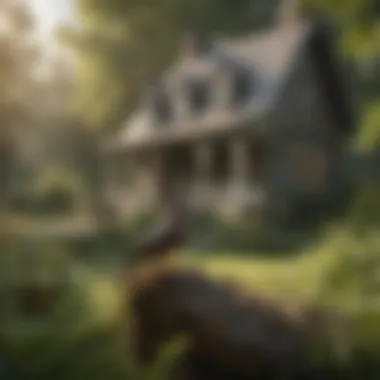

- Experience: Look for specialists who have a proven track record in managing woodpecker issues. Their experience can significantly impact the effectiveness of the strategies used.
- Certifications: Ensure that the exterminator or specialist holds appropriate certifications that comply with your local regulations concerning wildlife management.
- Reputation: Research online reviews and seek recommendations from neighbors or local community groups. Websites like Reddit and Facebook can offer insights into the experiences of others.
- Humane practices: It is crucial to choose a service that prioritizes humane solutions, which aligns with ethical wildlife management.
- Consultation services: A good professional will offer an initial consultation to assess the situation and recommend strategies tailored to your specific needs. This process should involve a transparent discussion of costs and expected outcomes.
"Professional input can make a significant difference in how effectively you can address woodpecker problems, ensuring that both your home and local wildlife are treated with respect."
By considering these elements, homeowners can make informed decisions that lead to effective and responsible woodpecker management.
Legal and Ethical Considerations
When dealing with woodpecker issues, it is essential to understand the legal and ethical considerations surrounding their management. This section addresses the importance of being informed about local wildlife regulations and the benefits of promoting coexistence with these birds. Such awareness safeguards both homeowners and woodpeckers, ensuring that any actions taken are responsible and legally compliant.
Understanding Local Wildlife Regulations
Wildlife regulations vary significantly by region. Before taking any action against woodpeckers, homeowners must comprehend the laws applicable in their area. Some species of woodpeckers may be protected under state or federal laws, making it illegal to harm, capture, or relocate them without the proper permits.
Homeowners should:
- Investigate local regulations on bird management through wildlife agencies or appropriate government websites.
- Seek guidance from local authorities if unsure about specific actions.
- Consider humane practices as a first line of defense against unwanted woodpecker activity.
By adhering to regulations, homeowners can prevent legal repercussions, such as fines or other penalties related to unauthorized actions.
Promoting Coexistence with Woodpeckers
Promoting coexistence with woodpeckers becomes invaluable in reducing conflict. Acknowledging these birds as part of the local ecosystem aids in finding strategies that respect their role while also protecting your property.
Homeowners can benefit from:
- Educating themselves about woodpecker behaviors and preferences. This understanding can inform methods to deter them without harm.
- Implementing non-lethal deterrents, such as visual or auditory distractions, which can effectively keep woodpeckers at bay while allowing them to continue their natural activities elsewhere.
- Creating environments that deter woodpeckers, such as maintaining the integrity of your home’s exterior or planting species that are unattractive to them, which may reduce their interest without resorting to harm.
Promoting coexistence is essential. It reflects an understanding that each species plays a role in our ecosystem, encouraging a balance between human needs and wildlife interests.
Monitoring and Maintenance
Monitoring and maintenance are essential for ensuring your strategies to keep woodpeckers at bay remain effective. Regular oversight will help you identify new problems quickly and adjust your methods accordingly. Managing woodpecker activity involves not just the initial preventative strategies but also the ongoing examination of their effectiveness.
By conducting routine inspections around your home, you can spot any signs of woodpecker activity early. Look for holes, drumming sounds, or even woodpecker droppings. Detecting these signs soon can help prevent further damage. You should also evaluate the materials and deterrents you are using; they need to withstand environmental factors. For example, reflective objects may lose their shine over time. Regular updates to your methods can keep your house unappealing to woodpeckers.
A critical part of this monitoring is maintaining a detailed log of your inspections. This log should track when and where woodpeckers are seen or heard, and the actions taken to deter them. It will help in analyzing patterns in woodpecker behavior and finding the most effective strategies.
Monitoring your environment regularly is key to effective woodpecker management. Regular checks help identify emerging problems before they escalate.
Regular Inspections and Updates
Regular inspections allow you to evaluate the effectiveness of your current deterrents. Perform these checks at least once a month during peak woodpecker activity seasons. Pay special attention to areas where infestations have occurred in the past. Checking for damage or new pecking sounds should be part of this inspection. If you notice that woodpeckers are returning to areas you thought were protected, it may be time to update your strategy. Consider enhancing your physical barriers or changing the placement of reflective objects to renew their efficacy.
Benefits of Consistent Inspections:
- Early Detection: Identify new woodpecker activity.
- Strategy Enhancement: Adjust measures based on effectiveness.
- Prevention of Damage: Stop the problem before it escalates into costly repairs.
Adjusting Strategies Based on Seasonality
Woodpecker activity can vary significantly throughout the year. Understanding these seasonal patterns is crucial. In warmer months, woodpeckers may be more active during nesting season. Monitoring their behavior during this time can inform you about potential risks to your home. It might be necessary to intensify deterrent actions such as hanging reflective materials or installing noise deterrents.
Conversely, during fall and winter, woodpeckers may seek food sources and shelter differently. Adjusting your bird feeders or removing excess food can make your home less attractive. Consistent reflections on seasonal changes allow for timely adjustments to your strategies, maximizing their efficiency throughout the year.
Concluding Remarks
In this article, we delved into effective strategies for repelling woodpeckers from residential properties. The importance of this topic cannot be overstated. Woodpeckers, while captivating creatures, can cause significant damage to homes and structures. Thus, understanding how to manage this issue through both humane and practical approaches is essential for homeowners.
Summary of Key Strategies
Key strategies include:
- Environmental modifications: Adjustments such as planting non-attractive vegetation can decrease the likelihood of woodpecker visits.
- Physical barriers: Installing netting and reflective objects can create obstacles that deter these birds effectively.
- Natural deterrents: Employing scents like peppermint oil can also serve as a means of warding off woodpeckers.
- Humane alternatives: Relocating nesting sites or using decoys to distract woodpeckers can promote coexistence.
- Professional services: When infestations become overwhelming, seeking expert assistance can be a viable option.
Implementing these strategies not only protects the home from damage but also contributes to the responsible management of local wildlife. Each approach has its relevance, making it crucial to assess the specific context of your situation.
Encouragement for Thoughtful Management
It is vital for homeowners to engage in thoughtful management practices regarding woodpecker interactions. Adopting a balanced perspective that considers both home protection and ecological health is essential.
By doing so, one contributes to the broader conversation about wildlife preservation while maintaining one's property. Thoughtful management means regularly monitoring woodpecker behavior, adjusting strategies based on seasonal changes, and remaining informed about local wildlife regulations.
This holistic approach not only ensures the safety of homes but also promotes a healthier environment for all inhabitants.
Ultimately, the aim is not just to repel woodpeckers, but to find a resolution that allows for coexistence, thereby enriching the relationship between humans and nature.





